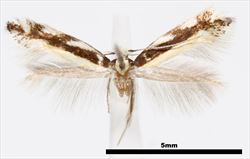OF BIOSECURITY CONCERN
Gelechioidea
Elachistidae (leaf and stem miners, borers and webbers)
3,300 approximate described species
Cosmopolitan particularly the New World
Arecaceae, Cyperaceae, Poaceae, Rosaceae
This family is distinguished by the lateral condyles on abdominal segments 5/6 and 6/7 puparia. Character serves as a polymorphy in Elachistinae and the ventral surface of A9 often has two submesal areas of recurved setae. Macro morphological characters for gelechioids are all symplesiomophies, however, there are synapomorphic micro morphological characters, including genitalia and pupal characters, for further delimitation. These techniques are not always viable, nor are the puparia always available, and in these instances it is preferable to identify straight to species.
Stenomatinae: head smooth with over-lapping lamellar scales; forewing without a pterostigma; frenulum with one or two bristles, retinaculum are subcostal bristles with cubital bristles along forewing, R5 reaches the costa, 1A+2A a simple vein; hind wing narrowly lanceolate, cell open, Rs and M1 possess a long stalk (Common 1990, Kristensen 1999).
Agonoxeninae: Head smooth scaled; exaggerated oblique frons; flattened labial palpi; absent antennal pecten; long piliform scales present on mid and hind tibia; forewing discal cell closed; R5 and M1 stalked with R5 terminating at costa, absent M3, M2 stalked or connate, CuP present; CuP and A in hind wing are small or absent, row of stout and recurved setae on anterior margin of hind wing (may appear as extension of Sc); uncus and socii absent, gnathos slender arms with a medial spined (rows of short spines) knob, valvae with hair-pencil on outer surface; short and curved aedeagus, cornuti absent; papillae anales large with short apophyses, the signum are a pair of dentate plates on an oval shaped corpus bursae (Common 1990, Kristensen 1999).
Atlas of Living Australia. National Research Infrastructure for Australia, NCRIS. http://www.ala.org.au/
ABRS 2009. Australian Faunal Directory. Australian Biological Resources Study, Canberra. http://www.environment.gov.au/biodiversity/abrs/online-resources/fauna/afd/index.html
Butterflies and moths of North America, collecting and sharing data about Lepidoptera. National Biological Information Infrastructure (NBII) Program and the USGS Northern Prairie Wildlife Research Center. http://butterfliesofamerica.com/links.htm
CSIRO Australian National Insect Collection Database. http://anic.ento.csiro.au/database/
CSIRO Ecosystem Sciences. Australian Moths Online. http://www1.ala.org.au/gallery2/main.php
Herbison-Evans D, Crossley S. Families of Moths in Australia. http://lepidoptera.butterflyhouse.com.au/moths.html
iBol Terrestrial Biosurveillance, Lepidoptera barcode of life. http://www.lepbarcoding.org/
Natural History Museum, The Global Lepidoptera Names Index. http://www.nhm.ac.uk/research-curation/research/projects/lepindex/search/index.dsml
Plant Health Australia (2012) Combined High Priority Pest List from Industry Biosecurity Plans. In National Plant Biosecurity Status Report, last accessed June 2015. http://www.planthealthaustralia.com.au/biosecurity/emergency-plant-pests/pest-categorisation/categorised-pests/
The Barcode of Life Data Systems http://www.boldsystems.org/
Common IFB (1990) In Moths of Australia, Melbourne University Press, Carlton, Victoria.
Kristensen NP (ed) (1999) Lepidoptera, Moths and Butterflies: Evolution, Systematics and Biogeography (vol. 1). Handbook of Zoology, Walter de Gruyter, Berlin.
Landry B, Roque-Albelo L (2003) Presence of Stenoma catenifer Walsingham (Lepidoptera, Elachistidae, Stenomatinae), the avocado seed moth, in the Galápagos. Noticias De Galápagos 62:15-16
Northern Australia Quarantine Strategy (2015) Entomology Internal Target List. Australian Government Department of Agriculture.
Operational Science Program (2015) Entomology Internal Target List. Australian Government Department of Agriculture.
van Nieukerken EJ, Kaila L, Kitching IJ, Kristensen NP, Lees DC, et al. (2011) Order Lepidoptera Linnaeus, 1758. In Zhang, Z.-Q. (Ed.) Animal Biodiversity: An outline of higher level classification and survey of taxonomic richness. Order Lepidoptera Linnaeus, 1758. Zootaxa. 3148: 212–221.

